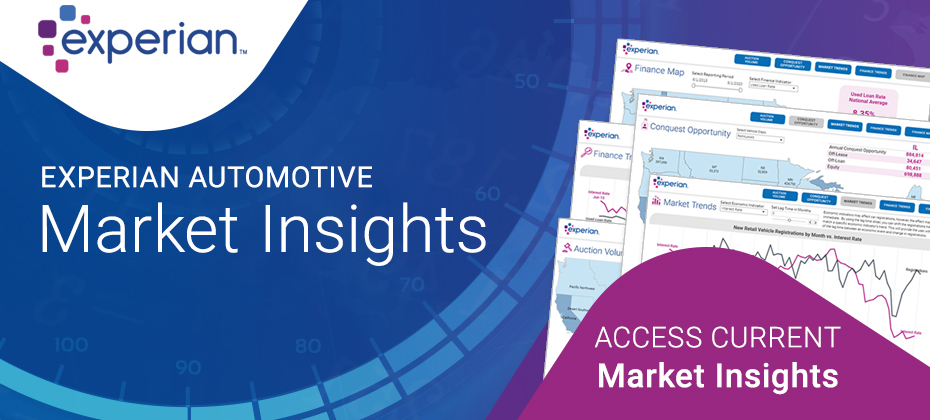Market Trends

According to Experian’s latest Global Insights Report, 38% of consumers expect to increase their online activity in the next 12 months. The report also found that consumers continue to have high expectations for their online experience, and businesses are re-imagining the customer journey to reflect that need. This January, Experian surveyed 3,000 consumers and 900 businesses to explore the changes in consumer behavior and business strategy pre- and post-COVID-19. As consumers have embraced life online, they’ve continued to emphasize their feelings regarding the importance of protecting their information. More than half of consumers still consider security to be the most important factor in their digital experience – the same experience they have such high expectations of. Business are acting in turn, with more than half investing in fraud detection methods or software to reduce friction in the customer experience. Digital transformation is also highlighting the need to: Manage regulatory compliance Integrate security measures Ensure access to AI models Attract and manage customers Integrate automation solutions Download the report to get all the latest insights into consumer desires and business behaviors, and keep visiting the Insights blog for a deeper dive into US-specific findings. Download report

Over the last several weeks, I’ve shared articles about the problems surrounding third-party, first-party and synthetic identity fraud. To wrap up this series, I’d like to talk about account takeover fraud and how digital transformation has impacted it over the last year. What is account takeover fraud? Account takeover fraud is a form of identity theft that involves unauthorized access to a user’s online accounts to enable financial crimes. Criminals can obtain information in a number of ways, including the dark web, spyware and malware, and phishing to allow them to make unauthorized transactions with the user’s account. Fraudsters have made efforts to also gain control of mobile or email accounts so they can intercept one-time passwords or password change instructions to retain control of the account. Once fraudsters have control of one account, they can use it to access other personal information to breach additional accounts and graduate to full-scale identity theft. How does account takeover fraud impact me? Account takeover fraud is damaging to businesses and consumers. It leads to losses and well as resources invested to confirm fraud. The potential losses from account takeover fraud have spiked over the last year, in large part due to the opportunities created by the rapid increase of digital interactions and the influx of users interacting with merchants and financial institutions online for the first time. Aite research shows that 64% of financial institutions are seeing higher rates of ATO fraud attacks now than prior to the pandemic. – Trace Fooshee, Senior Analyst, Aite Group1 Account takeover can also be difficult to detect. Unlike credit card fraud where the true owner might quickly notice suspicious charges, an account takeover attack can go undetected for long periods of time. That’s because the criminal can change login and contact information, ensuring that the real accountholder doesn’t realize they’ve been compromised immediately. Solving the account takeover fraud problem A good account takeover fraud prevention strategy requires two things: frictionless customer experience and robust risk management. It’s clear that customers expect seamless interactions with merchants and lenders. At the same time, businesses need to be able to spot risky or suspicious behavior before a bad transaction occurs. That’s where a layered fraud management solution comes into play. With the right tools—including risk-based identity and device authentication and targeted step-up authentication—businesses can provide a good customer experience and only pull in staff for deeper investigations where necessary. With this strategy in place, businesses can easily recognize good customers and provide a more personalized experience, while at the same time combatting fraud – boosting growth and minimizing losses in the long run. I hope this series has helped provide insights into the different types of fraud and why each of them requires different treatment. To learn more about the risks of account takeover and how a layered fraud management solution can help protect your business and your customers, feel free to contact us. 1Key Trends Driving Fraud Transformation in 2021 and Beyond, Aite Group, December 2020

Experian Automotive Market Insights dashboard provides a variety of insights to help dealers tackle their biggest challenges.

Small SUVs became the most financed vehicle segment in Q3 2020, making up 26.01% of all financed vehicles during the quarter.

2020 is finally over – been there, done that. And while it seems safe to say most everyone is all too eager to kick off a new calendar year, the reality is we’re still reeling – and will continue to reel – through the economic impacts of the COVID-19 global pandemic. As we inch closer to the one year marker of when many businesses were sent home – across all industries, including those tech-inclined and those less so – the understatement of the year is that the world has since changed as have consumer communication preferences, how businesses and customers interact, tweaked definitions of privacy, and new (heightened) expectations of evolving a positive customer experience with minimal friction and maximum security. While last year’s predictions of entering a new set of Roaring 20’s may not have panned out the way we had initially imagined, many of the trends thought to evolve over the last 365 days did. As we all look toward a post-pandemic world, here are six top trends to keep tabs on throughout 2021. 1. Data Data as a commodity and as a business differentiating factor has reached an all-time high. It’s doing more across the entire customer lifecycle and can elevate businesses to best prep for growth, especially as consumers begin to look for more financial products (whether looking for financial assistance as the CARES Act accommodation period ends, or to take advantage of the booming mortgage industry, etc.). Data can also give more insights into consumers than ever before. Far beyond just credit scores and financial data, today’s data sets can reveal consumers’ lifestyle preferences, their preferred communication channels, their rental histories, and so much more. With alternative credit data and non-traditional data (including consumer-permissioned data), businesses can get a holistic picture of their customers’ payment behaviors. That streaming media service monthly payment may seem minimal, but now could increase your credit score through Experian Boost. Experian is still making big strides in all efforts to use data for good. As of December 31, 2020, Experian Boost has “boosted” Americans’ credit scores nearly 47 million points. Additionally, throughout 2020, Experian worked with financial institutions and credit furnishers to continue to put consumers first and serve as the consumer’s bureau. Coming up in 2021? Using data for differentiation, which can ultimately drive business growth. From instant prescreens to identifying your best customers (and offering them cross-sell and upsell opportunities to increase retention and customer loyalty) to helping customers that may be on the brink of financial distress and connecting them with management solutions to help them get back on their feet, data can help businesses – and their customers – get there. 2. Fraud and Friction (And the Reduction of Both) With the pandemic, fraud saw increases across the board. Here are just some quick stats: 200% increase in first-time online banking usage immediately following shelter-in-place orders (Aite Group, “Workplace Distancing: Adapting Fraud and AML Operations to COVID-19,” April 2020) 652% year-over-year increase in records found on the dark web (Experian CyberAgent technology) 50% increase in human farming – real people being hired for purposes of fraud – month-over-month in March 2020 (Arkose Labs) And, unsurprisingly, consumer and business sentiments toward fraud are also evolving with these increasing trends. For example, according to Experian’s North America Trends Report, half of consumers continue to site security as the most important factor of their online experience. Additionally, there’s been an increase in the percentage of businesses who have recently increased or are planning to increase fraud budget from 76% in 2019 to 89% as of Sept. 2020. More complex phishing schemes and increased fraudster activity is due in part to numerous industries having to shift to online processes and business transactions overnight. Adoption for mobile wallets has jumped 11% since July 2020, according to the 2020 Global Insights Report. Systems and technology that were not ready or not armed with the necessary infrastructure left critical access points open that could be exploited by fraudsters. Fraud exists across the customer lifecycle, at every access point. And while fraud is complex, with Experian as your partner, solving it isn’t. Innovative technology enables businesses to prevent fraud by identifying credible customers and applying the correct treatment to the riskiest consumer and business accounts. We can help you develop a layered risk management strategy so you can focus resources on growing and protecting your customer relationships. 3. A New Administration – Changing of the Guards on the Regulatory Front With the new year enters the inauguration of a new president and administration. Though there is still much to be determined, certain areas are drawing a lot of attention with this changing of the guards. The highlights? The CFPB. Priorities and leadership could change. With COVID-19 top of mind, it is likely there will be aggressive agendas put forth to help protect the millions of consumers who have suffered economic distress and harm as a result of the pandemic. Data Portability. With an increased consumer appetite to port their data, questions and concerns around data security – and how to verify for a third party asking for the data – are also on the rise. There are a number of issues facing financial institutions around data portability, one of the largest being defining the line between consumer account information and proprietary data. All things privacy – state vs. national bills. The debate continues on how to move forward (whether privacy legislation will be handled by the states or at the national level), but for now it seems there is more progress at the state level. California was the first state to push through state-level privacy legislation in the form of the California Consumer Privacy Act of 2018. Twenty-four states are considering legislation that would require consent before collecting or disclosing personal information with third parties. 4. Analytics + Digitalization – Smarter, Better, Faster COVID-19 accelerated digital transformation for many. Some companies were ready, having already started making the headway in years prior, while others struggled – and some continue to struggle. The pandemic – and its corresponding recovery – is reason now, more than ever, to get some of your digital transformation priorities checked off of your list. Your customers demand it and your business needs it. Tackling analytics and digitalization not only brings your business up to speed, but improves your decisioning, enhances your offerings, and enables better platforms and data usage. In addition to digitalization, artificial intelligence for credit decisioning and personalized banking can also be expected to be a top trend, especially AI that is ethical and explainable, as will the increasing adoption and implementation of cloud computing. As consumer experience continues to reign supreme, any and all technology to enhance and improve that experience – think chatbots and virtual assistants – will also likely increase in presence. 5. Verification & Identity Identity has been a trending topic over the last few years, brought on by increasingly digital lifestyles and the intersection of personalization, frictionless transactions and adequate security. Identity verification and verification of other information such as income, employment and the like are increasingly needed in a today’s pandemic and tomorrow’s post-pandemic world. Leveraged across the lifecycle and during critical customer interactions, the need is especially heightened for insights, data accuracy, and diversification of data sets – to name a few. And while it was already established that identity verification is not just for marketing services, there are now even greater needs for financial institutions to be able to confidently know that their customers are who they say they are. Some areas to keep your eye on in 2021? Identity, income, assets and employment. 6. Redefining the Modern Mortgage As has been a common trend, spurred by the disruption caused by COVID-19, the mortgage industry is one of the many to have a magnifying glass brought to its areas for improvement. Some of those areas include operational efficiency, digital adoption and transparency. In line with the better and faster needs that lenders are continually trying to pace with, the need for speed is hitting mortgage originations, with an ideal situation outlined as closing in 30 days or less. Creating operational efficiencies through faster, fresher data can be the key for lenders to more accurately assess a borrower’s ability to pay upfront. Additionally, now, as most mortgage lenders are breaking previous origination records by a landslide (thanks pandemic), there’s new focus on other performance indicators. With such impetus, the modern mortgage is constantly evolving, incorporating customer-centric facets including a seamless digital process, providing meaningful customer experiences and leveraging the latest and greatest technology to better future-proof the industry through scalable technology, while aiming to reduce costs. For all your needs in 2021 and beyond, Experian has you covered. Learn More

No two customers are the same. That’s why it’s important to go beyond the traditional credit score for a closer look at each consumer’s individual circumstance and create personalized response plans. Learn more about some of the many different customers you’ll encounter and download our guide to get recommendations for every stage of the lifecycle. Get the Guide

According to Experian’s Q3 2020 State of the Automotive Finance Market report, 26.20% of all new vehicles are leased compared to 30.27% last year.

It’s clear that the digital transformation we experienced this year is here to stay. While there are many positives associated with this transformation – innovation, new ways to work, and greater online connectedness – it’s important that we review the risks associated with these trends as well. In late 2019 and throughout 2020, Experian surveyed consumers and businesses. We asked about online habits, expectations for information security and plans for future spending. Unsurprisingly, about half of consumers think they’ll continue to spend more online in the coming year. Those same consumers now have a higher expectation for their online experience than before the onset of COVID-19. Hand-in-hand with the online activity trends come increased risks associated with identity theft and fraud as criminals find new chances to steal information. In response to both of these trends, businesses and consumers want a balance between security and convenience. Our latest trends report dives into the new opportunities 2020 has created for fraud, and the opportunities to prevent identity theft or manipulation and the associated losses while building stronger relationships. Download the full North America Trends Report for a look into North American trends over the last year and to learn how fraud prevention and positive customer relationships are actually two sides of the same coin. North America Trends Report

Leveraging data to eliminate wasted ad spend will set your dealership up for success in the new year.

Experian recently announced the new members named to its Fintech Advisory Board. The board and its members provide Experian with valuable insights and key perspectives into the unique and quickly evolving needs of the fintech industry. “For years Experian has been committed to partnering with innovators in the fintech industry to bring better opportunities to businesses and consumers alike,” said Experian North American CEO Craig Boundy. “We appreciate the thought leadership we get from our Fintech Advisory Board members and the challenge and the push that comes along with it,” he said. The board met virtually last month, welcoming representatives from across the fintech ecosystem representing payments, personal and secured loan lenders, credit card issuers, investors and others. “This was my first board meeting with Experian, and I’m very pleased to see the investment Experian has put into being the best of the three major bureaus in having the best technology to enable us to turnaround our models more quickly, and better data and alternative data sources like Boost,” said one of the new executives appointed to the board. “We are delighted to gather this group of innovators together to ensure we are consistently meeting the needs of our fintech partners,” said Experian Vice President Jon Bailey, who oversees the fintech vertical. “Now more than ever it’s important that we work alongside them in shaping the industry and helping them meet their goals for the future,” he said. Experian’s fintech vertical provides leading-edge solutions and data across the credit lifecycle specifically designed to impact Fintech and marketplace lending companies and their customers. For more information on Experian’s fintech services or the advisory board, click here.

New challenges created by the COVID-19 pandemic have made it imperative for utility providers to adapt strategies and processes that preserve positive customer relationships. At the same time, they must ensure proper individualized customer treatment by using industry-specific risk scores and modeled income options at the time of onboarding As part of our ongoing Q&A perspective series, Shawn Rife, Experian’s Director of Risk Scoring, sat down with us to discuss consumer trends and their potential impact on the onboarding process. Q: Several utility providers use credit scoring to identify which customers are required to pay a deposit. How does the credit scoring process work and do traditional credit scores differ from industry-specific scores? The goal for utility providers is to onboard as many consumers as possible without having to obtain security deposits. The use of traditional credit scoring can be key to maximizing consumer opportunities. To that end, credit can be used even for consumers with little or no past-payment history in order to prove their financial ability to take on utility payments. Q: How can the utilities industry use consumer income information to help identify consumers who are eligible for income assistance programs? Typically, income information is used to promote inclusion and maximize onboarding, rather than to decline/exclude consumers. A key use of income data within the utility space is to identify the eligibility for need-based financial aid programs and provide relief to the consumers who need it most. Q: Many utility providers stop the onboarding process and apply a larger deposit when they do not get a “hit” on a certain customer. Is there additional data available to score these “no hit” customers and turn a deposit into an approval? Yes, various additional data sources that can be leveraged to drive first or second chances that would otherwise be unattainable. These sources include, but are not limited to, alternative payment data, full-file public record information and other forms of consumer-permissioned payment data. Q: Have you noticed any employment trends due to the COVID-19 pandemic? How can those be applied at the time of onboarding? According to Experian’s latest State of the Economy Report, the U.S. labor market continues to have a slow recovery amidst the current COVID-19 crisis, with the unemployment rate at 7.9% in September. While the ongoing effects on unemployment are still unknown, there’s a good chance that several job/employment categories will be disproportionately affected long-term, which could have ramifications on employment rates and earnings. To that end, Experian has developed exclusive capabilities to help utility providers identify impacted consumers and target programs aimed at providing financial assistance. Ultimately, the usage of income and employment/unemployment data should increase in the future as it can be highly predictive of a consumer’s ability to pay For more insight on how to enhance your collection processes and capabilities, watch our Experian Symposium Series event on-demand. Watch now Learn more About our Experts: Shawn Rife, Director of Risk Scoring, Experian Consumer Information Services, North America Shawn manages Experian’s credit risk scoring models while empowering clients to maximize the scope and influence of their lending universe. He leads the implementation of alternative credit data within the lending environment, as well as key product implementation initiatives.

Enterprise Security Magazine recently named Experian a Top 10 Fraud and Breach Protection Solutions Provider for 2020. Accelerating trends in the digital economy--stemming from stay-at-home orders and rapid increases in e-commerce and government funding--have created an attractive environment for fraudsters. At the same time, there’s been an uptick in the amount of personally identifiable information (PII) available on the dark web. This combination makes innovative fraud and breach solutions more crucial than ever. Enterprise Security Magazine met with Kathleen Peters, Experian’s Chief Innovation Officer, and Michael Bruemmer, Vice President of Global Data Breach and Consumer Protection, to discuss COVID-19 digital trends, the need for robust fraud protection, and how Experian’s end-to-end breach protection services help businesses protect consumers from fraud. According to the magazine, “With Experian’s best in class analytics, clients can rapidly respond to ever-changing environments by utilizing offerings such as CrossCore® and Sure ProfileTM to identify and prevent fraud.” In addition to our commitment to develop new products to combat the rising threat of fraud, Experian is focused on helping businesses minimize the consequences of a data breach. The magazine noted that, “To serve as a one-stop-shop for data breach protection, Experian offers a wide range of auxiliary services such as incident management, data breach notification, identity protection, and call center support.” We are continuously working to create and integrate innovative and robust solutions to prevent and manage different types of data breaches and fraud. Read the full article Contact us

The shift created by the COVID-19 pandemic is still being realized. One thing that we know for sure is that North American consumers’ expectations continue to rise, with a focus on online security and their digital experience. In mid-September of this year, Experian surveyed 3,000 consumers and 900 businesses worldwide—with 300 consumers and 90 businesses in the U.S.—to explore the shifts in consumer behavior and business strategy pre- and post-COVID-19. More than half of consumers surveyed continue to expect more security steps when online, including more visible security measures in place on websites and more knowledge about how their data is being protected and stored. However, those same consumers aren’t willing to wait more than 60 seconds to complete an online transaction making it more important than ever to align your security and experience strategies. While U.S. consumers are optimistic about the economy’s recovery, they are still dealing with financial challenges and their behaviors have changed. Future business plans should take into account consumers’: High expectations of their online experience Increases in online spending Difficulty paying bills Reduction in discretionary spending Moving forward, businesses are focusing on use of AI, online security, and digital engagement. They are emphasizing revenue generation while looking into the future of online security. Nearly 70% of businesses also plan to increase their fraud management budgets in the next 6 months. Download the full North America Insights Report to get all of the insights into North American business and consumer needs and priorities and keep visiting the Insights blog in the coming weeks for a look at how trends have changed from early in the pandemic. North America Insights Report Global Insights Report

In the wake of unprecedented unemployment fraud since the start of COVID-19, Experian announced it was selected as the exclusive partner for identity and fraud verification for the Unemployment Insurance (UI) Integrity Center’s centralized Identity Verification (IDV) capability. IDV is available to state agencies at no cost through UI Integrity Center, which is operated by the National Association of Workforce Agencies (NASWA) in partnership with the U.S. Department of Labor. With the Federal Bureau of Investigations (FBI) reporting a spike in fraudulent unemployment insurance claims complaints related to COVID-19, it’s more important than ever for state agencies to use innovative solutions to verify identities that are applying for unemployment insurance to protect consumers. If improper unemployment insurance payments are made to fraudsters, the efforts of the CARES Act could be largely wasted. The IDV capability leverages Experian’s Precise IDTM to provide a centralized identity verification and proofing solution. Precise ID combines identity analytics with advanced fraud risk models to distinguish various types of fraud, which can help state agencies maximize time and resources. When state agencies submit claims, the IDV solution will return ID theft scoring and associated cause codes, enabling them to assess whether a claim may be fraudulent. “Due to the COVID-19 health crisis, unemployment is high, with over roughly 60 million Americans filing for unemployment since March,” said Robert Boxberger, president of Experian’s Decision Analytics in North America. “At Experian, we’re proud to have a strong culture dedicated to continuous innovation that helps protect consumers’ financial health. We’re taking that same consumer focus and helping make the unemployment insurance application process more efficient and safer for constituents.” The Integrity Data Hub (IDH) is a robust, multi-state data system that contains a continuously expanding set of sources to provide advanced cross-matching and analytic capabilities to states. It is designed to be easily implemented by any state Unemployment Insurance agency, regardless of claim volume, technology, or access to internal resources. The IDH was designed and built using the latest National Institute of Standards and Technology IT security standards, including the use of asymmetric encryption and other techniques to ensure the security of sensitive data. “We’re excited to partner with Experian and utilize its Precise ID solution to assist states in mitigating fraud during these unprecedented times,” said Scott Sanders, NASWA Executive Director. “States are finding this to be a very valuable tool and we are pleased that we can offer this solution to states through our partnership with the U.S. Department of Labor.” Read Press Release Learn More About Precise ID

No one can deny that the mortgage and real estate industries have been uniquely affected by COVID-19. Social distancing mandates have hindered open house formats and schedules. Meanwhile, historically low-interest rates, pent-up demand and low housing inventory created a frenzied sellers’ market with multiple offers, usually over-asking. Added to this are the increased scrutiny of how much borrowers will qualify and get approved for with tightened investor guidelines, and the need to verify continued employment to ensure a buyer maintains qualifying status through closing. As someone who’s spent more than 15 years in the industry and worked on all sides of the transaction (as a realtor and for direct lenders), I’ve lived through the efforts to revamp and digitize the process. However, it wasn’t until recently that I purchased my first home and experienced the mortgage process as a consumer. And it was clear that, for most lenders, the pandemic has only served to shine a light on a still somewhat fragmented mortgage process and clunky consumer experience. Here are three key components missing from a truly modernized mortgage experience: Operational efficiency Knowing that the industry had made moves toward a digital mortgage process, I hoped for a more streamlined and seamless flow of documents, loan deliverables and communication with the lender. However, the process I experienced was more manual than expected and disjointed at times. Looking at a purchase transaction from end to end, there are at least nine parties involved: buyer, seller, realtors, lender, home inspectors/inspection vendors, appraiser, escrow company and notary. With all those touchpoints in play, it takes a concerted effort between all parties and no unforeseen issues for a loan to be originated faster than 30 days. Meanwhile, the opposite has been happening, with the average time to close a loan increasing to 49 days since the beginning of the pandemic, per Ellie Mae’s Origination Insights Report. Faster access to fresher data can reduce the time to originate a mortgage. This saves resource hours for the lender, which equates to savings that can ultimately be passed down to the borrower. Digital adoption There are parts of the mortgage process that have been digitized, yes. However, the mortgage process still has points void of digital connectivity for it to truly be called an end-to-end digital process. The borrower is still required to track down various documents from different sources and the paperwork process still feels very “manual.” Printing, signing and scanning documents back to the lender to underwrite the loan add to the manual nature of the process. Unless the borrower always has all documents digitally organized, requirements like obtaining your W-2’s and paystubs, and continuously providing bank and brokerage statements to the lender, make for an awkward process. Modernizing the mortgage end-to-end with the right kind of data and technology reduces the number of manual processes and translates into lower costs to produce a mortgage. Turn times are being pushed out when the opposite could be happening. A streamlined, modernized approach between the lender and consumer not only saves time and money for both parties, it ultimately enables the lender to add value by providing a better consumer experience. Transparency Digital adoption and better digital end-to-end process are not the only keys to a better consumer experience; transparency is another integral part of modernizing the mortgage process. More transparency for the borrower starts with a true understanding of the amount for which one can qualify. This means when the loan is in underwriting, there needs to be a better understanding of the loan status and the ability to better anticipate and be proactive about loan conditions. Additionally, the lender can profit from gaining more transparency and visibility into a borrower’s income streams and assets for a more efficient and holistic picture of their ability to pay upfront. This allows for a more streamlined process and enables the lender to close efficiently without sacrificing quality underwriting. A multitude of factors have come into play since the beginning of the pandemic – social distancing mandates have led to breakdowns in a traditionally face-to-face process of obtaining a mortgage, highlighting areas for improvement. Can it be done faster, more seamlessly? Absolutely. In ideal situations, mortgage originators can consistently close in 30 days or less. Creating operational efficiencies through faster, fresher data can be the key for a lender to more accurately assess a borrower’s ability to pay upfront. At the same time, a digital-first approach enhances the consumer experience so they can have a frictionless, transparent mortgage process. With technology, better data, and the right kind of innovation, there can be a truly end-to-end digital process and a more informed consumer. Learn more